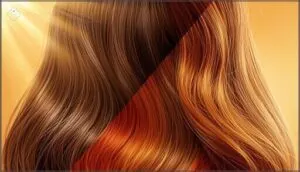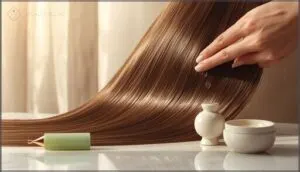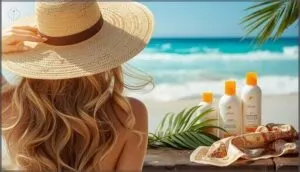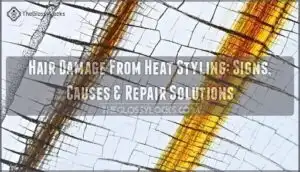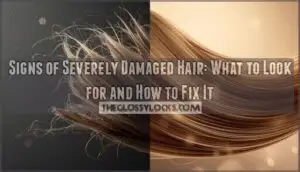This site is supported by our readers. We may earn a commission, at no cost to you, if you purchase through links.
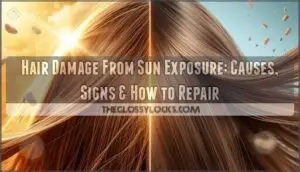
Your hair faces an invisible threat every time you step outside. UV radiation doesn’t just damage your skin—it breaks down the proteins and melanin in each strand, leaving your hair dry, brittle, and prone to breakage. If you’ve noticed your locks looking dull after a beach vacation or your color fading faster in summer, you’re witnessing hair damage from sun exposure firsthand.
The good news? Once you understand how UV rays alter your hair’s structure, you can take specific steps to repair the damage and shield your strands from future harm. Whether you’re dealing with split ends, frizz, or color that won’t hold, restoring your hair’s health starts with knowing what went wrong.
Table Of Contents
Key Takeaways
- UV radiation breaks down keratin proteins and melanin in your hair, causing up to 40% moisture loss and significantly weakening strand structure—especially in bleached or chemically treated hair that’s lost its natural defenses.
- Sun damage shows up as dryness, brittleness, split ends, color fading, and scalp sunburn, with blonde hair losing up to seven times more protein than darker shades due to lower melanin protection.
- Repairing sun-damaged hair requires a three-part approach: deep conditioning to restore moisture, protein treatments to rebuild keratin bonds, and regular trims every 6-8 weeks to prevent split ends from traveling up the shaft.
- Prevention beats repair—wear wide-brimmed hats that block 76% of UV exposure, apply hair sunscreen every two hours, rinse immediately after swimming to remove chlorine and saltwater, and skip heat styling above 300°F to avoid compounding the damage.
What Causes Sun Damage to Hair?
Your hair faces more than just sunlight when you’re outside. UV rays team up with other elements—like pool chemicals, styling heat, and even your own hair treatments—to weaken your strands from the inside out.
Let’s break down what’s actually happening when the sun damages your hair.
UV Radiation and Hair Protein Breakdown
When UV radiation hits your hair, it doesn’t just fade the color—it attacks the proteins holding everything together. UVB rays cause substantial protein loss by breaking down keratin and damaging disulfide bonds that give your hair strength. Meanwhile, UVA impact focuses on melanin degradation, causing noticeable color changes.
The longer the exposure duration, the worse the keratin degradation becomes, leaving strands weak and brittle. Prolonged exposure can also substantially impact the hair’s lipid content, leading to dryness.
Effects of Chlorine and Saltwater
Chlorine damage from pools and saltwater effects at the beach make your hair extra vulnerable to sun exposure. When combined, they strip away natural oils and break down keratin more aggressively than sun alone.
Here’s what happens when these elements team up:
- Chlorine dissolves protective lipids, reducing moisture by up to 36% in hair strength
- Saltwater dehydrates strands by pulling moisture from your hair shaft
- Combined damage accelerates color fading, especially in chemically treated hair
- Your hair cuticles lift and roughen, creating pathways for further breakage
- Protective measures like pre-wetting hair can cut chlorine absorption by 50%
Fine, bleached, or color-treated hair faces the highest risk of sun damage and needs careful hair protection. This can lead to increased hair breakage, making strands more fragile. Post-swim rinsing is essential hair care.
Heat Styling and Environmental Stress
Beyond the pool, heat styling paired with sun exposure creates a double-whammy for your hair. Environmental factors like wind, dry air, and pollution add even more oxidative stress effects.
| Stressor | Hair Damage Effect |
|---|---|
| Heat Tools (>300°F) | Thermal protein damage, moisture loss |
| UV + Heat | Cuticle resistance breakdown, frizz |
| Humidity | Humidity amplification of UV harm |
Hair care means protecting from multiple angles. Hair repair starts with recognizing these combined threats.
Chemical Treatments Increasing Vulnerability
If you’ve bleached, dyed, or relaxed your hair, you’ve unknowingly opened the door to accelerated sun damage. Chemical treatments strip away melanin and protective lipid layers, leaving hair more porous and vulnerable. Bleach UV damage happens faster because there’s less natural defense. Relaxer cortex weakening and dye lipid stripping mean your strands can’t bounce back from sun exposure like they used to.
- Bleaching removes melanin, your hair’s built-in sunscreen, making UV rays penetrate deeper
- Perming disulfide disruption breaks protein bonds, reducing your hair’s strength against environmental stress
- Chemical aftercare matters—deep conditioning and UV protectants help rebuild what treatments took away
Signs and Symptoms of Sun-Damaged Hair
Your hair will tell you when it’s been in the sun too long—you just need to know what to look for. Sun damage shows up in several distinct ways, from changes in texture to shifts in color and overall hair health.
Let’s walk through the most common signs so you can catch them early and take action.
Dryness, Brittleness, and Frizz
When UV rays hit your hair, they’re like tiny scissors cutting away at the bonds that keep it strong. You’ll notice dry, frizzy hair that feels rough to the touch—a telltale sign of sun-damaged hair. Studies show UV-induced dryness can rob your strands of up to 40% of their strength, while protein breakdown makes blonde hair lose seven times more structure than darker shades.
UV rays act like microscopic scissors on your hair, cutting protein bonds and stripping up to 40% of its strength
| Sun Damage Sign | What’s Happening |
|---|---|
| Hair dryness and straw-like texture | UV radiation strips natural oils and moisture |
| Brittle strands that snap easily | Protein breakdown weakens hair’s keratin structure |
| Frizzy texture and unmanageable hair | Disulfide bonds reform in distorted shapes |
| Rough, lifeless appearance | Environmental interaction compounds cuticle damage |
These quantifiable changes aren’t just cosmetic—they signal real structural damage that worsens with heat styling, chlorine, and saltwater exposure.
Faded or Discolored Hair Color
When UV radiation hits your hair, it attacks melanin—the pigment that gives your color depth. You’ll see blonde hair turn brassy or reddish, while darker shades lose their richness and shine. Here’s what happens:
- UV rays break down melanin molecules, causing hair color fading that intensifies over weeks
- Protein damage weakens color retention, making dyes fade nearly completely after seven weeks of sun exposure
- Color shifts produce unwanted warm tones as your hair’s chemical composition changes
Sun exposure doesn’t just lighten—it distorts your entire shade.
Split Ends and Hair Breakage
Split ends and hair breakage reveal UV damage at its worst. Sun exposure weakens the hair shaft by up to 30%, making brittle strands snap easily during brushing or styling. Mitigating damage starts with recognizing these warning signs in your sun-damaged hair.
Here’s the UV breakage link:
| Environmental Stressors | Structural Weakness | Preventative Measures |
|---|---|---|
| UV radiation + chlorine | 40% protein loss | Regular trims every 6-8 weeks |
| Heat styling + sun | Decreased tensile strength | Deep conditioning treatments |
| Physical manipulation | Roughened cuticle surface | Protective hairstyles |
Sunburned or Irritated Scalp
Your scalp bears the brunt when hair can’t shield it completely. Scalp sunburn symptoms include redness, pain, and inflammation appearing within hours of UV radiation impact on follicle health. One in five Americans develops skin cancer by 70, making scalp protection non-negotiable.
Watch for these warning signs:
- Tender, inflamed patches that hurt when touched or combed
- Yellow crusting or peeling skin indicating barrier damage
- Temporary hair shedding from stressed follicles
Sunburn management starts with scalp sunscreen and wide-brimmed hats. Scalp care for sun damage means cooling treatments and preventing recurrence through daily UV defense.
How Sun Exposure Changes Hair Structure
When the sun beats down on your hair, it doesn’t just change how it looks—it actually alters the structure from the inside out. Think of your hair like a protective shield that slowly breaks down under UV exposure, losing its ability to lock in moisture and stay strong.
Let’s look at the specific ways sun exposure damages your hair’s natural structure.
Damage to Hair Cuticles and Moisture Loss
Think of your hair cuticle as protective armor—except UV radiation punches holes in it, expanding them by 350% and stripping away layers. This cuticle layer damage allows moisture to escape, leaving your hair dry and brittle.
The sun also disrupts the lipid layer that seals in hydration, leading to significant hair moisture loss. Fine or chemically treated hair shows greater hair type vulnerability to this sun damaged hair.
Disruption of Hair Protein and Lipid Layers
Your hair’s internal framework takes a real beating from the sun. UV rays attack keratin proteins and lipids that hold everything together, especially the amino acids tryptophan and cysteine—critical building blocks of your hair structure.
Here’s what happens beneath the surface:
- Protein degradation weakens disulfide bonds, reducing your hair’s tensile strength
- Lipid oxidation destroys up to 40% of protective fatty acids with UVB exposure
- Free radicals accelerate breakdown of both protein and lipid components
- Structural changes disrupt hydrogen bonds, making hair stiff and rough
- Pigmentation impact varies—blond hair suffers greater lipid damage than darker types
Breakdown of Melanin and Color Fading
Beyond the protein and lipid damage lies another visible consequence—your hair color itself fades under UV radiation. Melanin, the pigment giving your hair its unique shade, breaks down when sunlight hits it. UV rays between 254–350 nm specifically target melanin molecules, causing permanent color loss until new hair grows in.
Here’s how different hair types respond:
| Hair Color | Melanin Type | UV Vulnerability |
|---|---|---|
| Dark brown/black | Eumelanin (high) | Lower color fading, better photoprotection |
| Blond/light brown | Pheomelanin (high) | Greater color change, increased protein loss |
| White/gray | No melanin | Highest susceptibility, yellowing common |
The sun’s effect on hair color isn’t random. UVA radiation penetrates deep into your hair’s cortex, degrading melanin and causing that washed-out look you’ve probably noticed after summer. Lighter hair shows more dramatic color changes—blond hair can lose up to 63% of artificial color with prolonged exposure.
Melanin types matter for photoprotection measures too. Eumelanin in darker hair acts like a shield, absorbing harmful UV and converting it to heat. But this protection comes at a cost—melanin gradually sacrifices itself, breaking down through oxidation. Once it’s gone, your hair loses its natural defense system.
Protein loss accelerates alongside color fading. UVB radiation causes 2 to 5 times more protein damage than UVA, and after 448 hours of sun exposure, blond hair loses twice as much protein as it did initially. That’s why sun-damaged hair doesn’t just look different—it feels weaker and more brittle.
Repairing Hair Damaged by Sun Exposure
Once sun damage has set in, your hair needs focused repair to regain its strength and shine. The good news is that with the right treatments, you can restore moisture, rebuild weakened strands, and prevent further breakage.
Let’s look at three key strategies that work together to bring sun-damaged hair back to health.
Deep Conditioning and Hydration Treatments
When UV exposure leaves your hair feeling like straw, deep conditioning masks work wonders to bring it back to life. These hair conditioning treatments restore hair moisture by replenishing lost lipids and boosting hair hydration at the cuticle level.
Look for leave-in conditioners with natural agents like coconut oil or aloe vera—they boost scalp hydration while improving overall hydration effectiveness after sun damage.
Protein and Restorative Hair Masks
While moisture gets your hair to drink, protein treatments rebuild what UV rays broke down. These hair masks deliver hydrolyzed proteins deep into weakened strands, reinforcing damaged keratin bonds from the inside out. When used weekly, protein treatments can slash breakage by up to 50%.
Here’s what makes protein treatments effective for repairing damaged hair:
- Keratin and collagen rebuild your hair’s structural foundation after sun exposure
- Hydrolyzed proteins penetrate the cuticle, delivering amino acids for molecular-level repair
- Restorative effects counteract UV-induced brittleness and protein breakdown
- Proper mask application involves combing through towel-dried hair and allowing time to penetrate
- Usage limitations matter—overuse causes protein overload, making hair stiff and prone to snapping
Balance is key. Alternate between protein and moisture masks to keep your hair strong without tipping into dryness.
Trimming Split Ends and Gentle Styling
Once protein strengthens your strands, removing damaged ends stops split ends from climbing upward. Trimming every 6-8 weeks cuts breakage by up to 50% while improving texture and shine. Your trim frequency depends on sun exposure—more time outdoors means more frequent micro-trims.
Gentle detangling with wide-tooth combs prevents mechanical hair breakage. Healthier ends mean better manageability gains—your hair absorbs conditioners more effectively and holds styles without constant fussing.
| Styling Practices | Breakage Impact |
|---|---|
| Skip heat tools | Preserves moisture |
| Loose braids/buns | Reduces friction |
| Leave-in serums | Shields from stress |
| Air drying | Aids in repair |
Preventing Future Sun Damage to Hair
Now that you’ve started repairing the damage, it’s time to think about keeping your hair protected going forward. The good news is that preventing future sun damage doesn’t require a complete lifestyle overhaul.
Let’s look at some practical steps you can take to shield your hair from UV rays and keep it healthy all year long.
Wearing Hats and Protective Accessories
Think of your hat as a personal shield against UV radiation. Wide-brimmed options reduce facial UV exposure by up to 76%, while protecting your scalp from direct damage. Choose breathable hat material like cotton or linen to maintain scalp hygiene. Make sure the hat fits well—too tight can trigger traction alopecia.
Headscarves and hair accessories work beautifully too, protecting hair from sun while keeping things stylish and comfortable.
Using Hair Sunscreens and UV-Protectant Sprays
Hair sunscreen and UV protection sprays form a chemical barrier against damaging rays. Apply these products to damp or dry hair, focusing on ends and sun-exposed areas. Reapply every two hours—especially after swimming.
Look for formulas with UV filters and antioxidants that shield melanin from breakdown.
Don’t forget scalp protection with targeted SPF products, since your scalp needs defense too.
Avoiding Heat Styling and Harsh Chemicals
When you step back from blow dryers and flat irons, your hair gets a real chance to heal. Heat styling above 300°F permanently weakens hair structure, and harsh chemical treatments like bleaching strip away your hair’s natural defenses.
Try air-drying benefits instead—let your hair reach 90% dry naturally before any heat touches it. Pair sulfate-free shampoos with regular trims to remove damaged ends and prevent further breakage.
Protective Hairstyles for Sun Protection
Smart styling does double duty—fashion and function unite when you braid, twist, or cover your hair. These styles boost your HUPF increase while preventing sun damage to hair and scalp erythema.
- Braids and cornrows create a barrier reducing melanin photodegradation by up to 30%
- Buns and topknots improve moisture retention by 18% under sun exposure
- Head wraps and scarves block UV rays completely, protecting hair from sun damage
- Knotless braids minimize protein loss while reducing scalp stress during prolonged exposure
Pair hair sunscreen with protective styling for maximum defense.
Best Practices for Healthy, Sun-Protected Hair
You’ve learned how to protect and repair sun-damaged hair, but the real key is building a daily routine that keeps your hair healthy year-round. Think of it as creating a shield before your hair even faces the sun.
Let’s walk through the essential habits that’ll keep your strands strong, shiny, and protected no matter the season.
Choosing The Right Shampoos and Conditioners
Your shampoo and conditioner choices matter more than you might think. Look for sulfate-free options with UV protection and keratin complexes—these ingredients help preserve color vibrancy while repairing damage. Products like Garnier Fructis Color Shield or L’Oréal Absolut Repair deliver measurable results.
Daily conditioners and leave-in treatments fortify your hair’s defenses. Color-protecting shampoos with vitamin C prevent sun-induced fading while keeping strands manageable.
Nutritional Support for Hair Health
Think of your diet as hair insurance from the inside out. Vitamin C drives collagen production, while vitamin A bolsters scalp health and cell growth. Essential vitamins like biotin strengthen keratin networks, and fatty acids combat inflammation tied to hair loss. Mineral support from zinc and iron maintains follicle health.
Clinical evidence shows that nutrient-rich dietary patterns—lean proteins, antioxidants, whole grains—markedly improve hair density and resilience against UV damage.
Scalp Care and Sunscreen Application
Your scalp needs sunscreen just like your face does—especially if you have thinning hair or visible parts. SPF 50 filters 98% of UV radiation, protecting against sunburn and long-term damage. Apply lightweight spray or lotion to exposed areas, reapplying every two hours. Product formulation matters: broad-spectrum protection guards against both UVA and UVB rays.
Consider these clinical recommendations for scalp protection:
- Wide-brimmed hats dramatically lower UV exposure to your scalp and hairline
- Water-resistant sunscreen maintains protection during swimming or sweating
- Spray formulations reach hard-to-access areas and won’t leave greasy residue
- Early intervention prevents actinic keratoses, a precursor to skin cancer
Application techniques make all the difference. Focus on your hairline, part, and any thinning spots where your scalp peeks through.
Rinsing Hair After Swimming or Sun Exposure
After you protect your scalp, rinsing becomes your next defense. Fresh water immediately after swimming removes chlorine and saltwater that strip natural oils and cause brittleness.
Studies show rinsing reduces dryness by 40-60% compared to leaving residues in your hair. Use lukewarm water before shampooing—this simple habit prevents color fading, maintains scalp health, and minimizes sun exposure damage from summer hair care activities.
Frequently Asked Questions (FAQs)
How long does it take hair to recover?
Hair damage repair depends on severity and your hair type. With consistent treatment, you’ll see measurable outcomes in moisture and strength within 2-4 weeks, though complete recovery through growth cycles takes several months.
Are natural oils effective for sun protection?
Coconut and olive oils create a light shield with SPF values around 8, while raspberry seed oil reaches SPF 28-
But don’t rely on them alone—combine with hats and dedicated UV sprays for real protection.
Should you wash hair immediately after sun exposure?
Yes, you should rinse your hair right after sun exposure. Immediate washing removes chlorine, saltwater, and residue that worsen dryness.
Use gentle, sulfate-free shampoo and follow with deep conditioner to restore moisture.
Conclusion
An ounce of prevention is worth a pound of cure—and that’s especially true regarding hair damage from sun exposure. Wear a hat, use UV-protectant sprays, and rinse after swimming. Protecting your strands today means healthier, stronger hair tomorrow. Your future self will thank you.
Your hair can bounce back from UV stress with deep conditioning, protein treatments, and consistent moisture. But why wait for the damage to happen?


